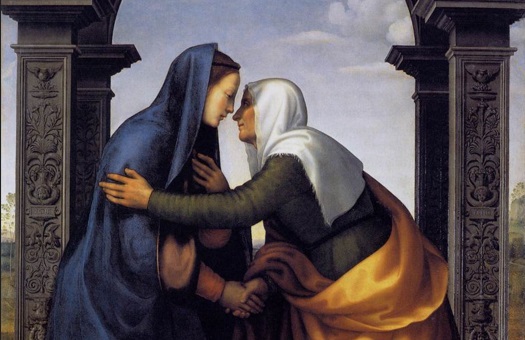
“A GREAT SIGN APPEARED IN HEAVEN: A WOMAN CLOTHED WITH THE SUN, AND THE MOON BENEATH HER FEET”

Most years on August 14, my wife Nora and I make the one-hour drive northeast from Edmonton to the Marian grotto at Skaro to participate in the vigil Mass of Mary’s bodily assumption into heaven. The grotto was built by an enormous outpouring of labour and faith by the area’s Polish and Ukrainian settlers in the early twentieth century.
The vigil culminates with a beautiful twilight procession up the grotto where pilgrims leave their candles as signs of the prayers which they hope the Blessed Virgin will take to her Divine Son. (A photo of that procession graces the cover of this month’s issue of Living With Christ.)
The Assumption is the Catholic feast which is likely the occasion of the most pilgrimages of any event on the liturgical calendar. It is not immediately evident why that should be the case. The doctrine of Mary’s Assumption, which Pope Pius XII solemnly defined in 1950, is far from central to Catholic belief.
The doctrines of the resurrection (Easter), the incarnation (the Annunciation and Christmas) and the ongoing presence of the Holy Spirit (Pentecost) represent the core of Christian faith. The bodily assumption of Mary into heaven, which has been celebrated in the liturgy since at least the sixth century, offers hope of eternal life to all who believe in Christ. It derives from our Easter faith rather than providing a foundation for that faith.
The Assumption is celebrated mid-summer in the northern hemisphere when the days are still long and the evenings (usually) warm. It is a fine time for an outdoor liturgy. As well, even in these secular times, Catholic popular devotion to Our Lady remains strong. So, why not celebrate?
Still, understanding of the doctrine is sometimes murky. Joseph MacNeil, the late archbishop of Edmonton, recounted one homily on the Assumption he gave while a young priest in Nova Scotia. A man approached him later and declared, “That was a fine homily, Father. I really learned something from it.”
MacNeil responded, “Oh, and what was that?”
“Father, I learned that our belief in Mary being taken into heaven is an assumption.”
Such an answer might have caused Pope Pius to recoil in horror. For the pope, the definition of the doctrine of the Assumption was desperately needed in the post-Second World War world. Unfortunately, all the trials facing the world at that time – the threat of nuclear destruction, social inequality, the triumph of technology, the possibility of another major war and others – remain.
Author and English professor Sally Cunneen wrote that 1950 definition of the doctrine was the climax of the nineteenth century’s “Catholic obsession with Mary.” That obsession grew out of an earlier theology which viewed Mary more as Christ’s bride than as Jesus’ mother and which called on the faithful to be “slaves” to Mary since no communication with Christ was possible without her mediation. (In Search of Mary: The Woman and the Symbol)
Although such theological distortions have gone into remission, Mary is still revered, and the doctrine remains unquestioned. Mary and her bodily assumption remain signs of eternal hope in a world where the powerful habitually ignore the pleas of the poor, the forgotten and even ordinary folks. Mary is the one who shows the way to follow Jesus.
